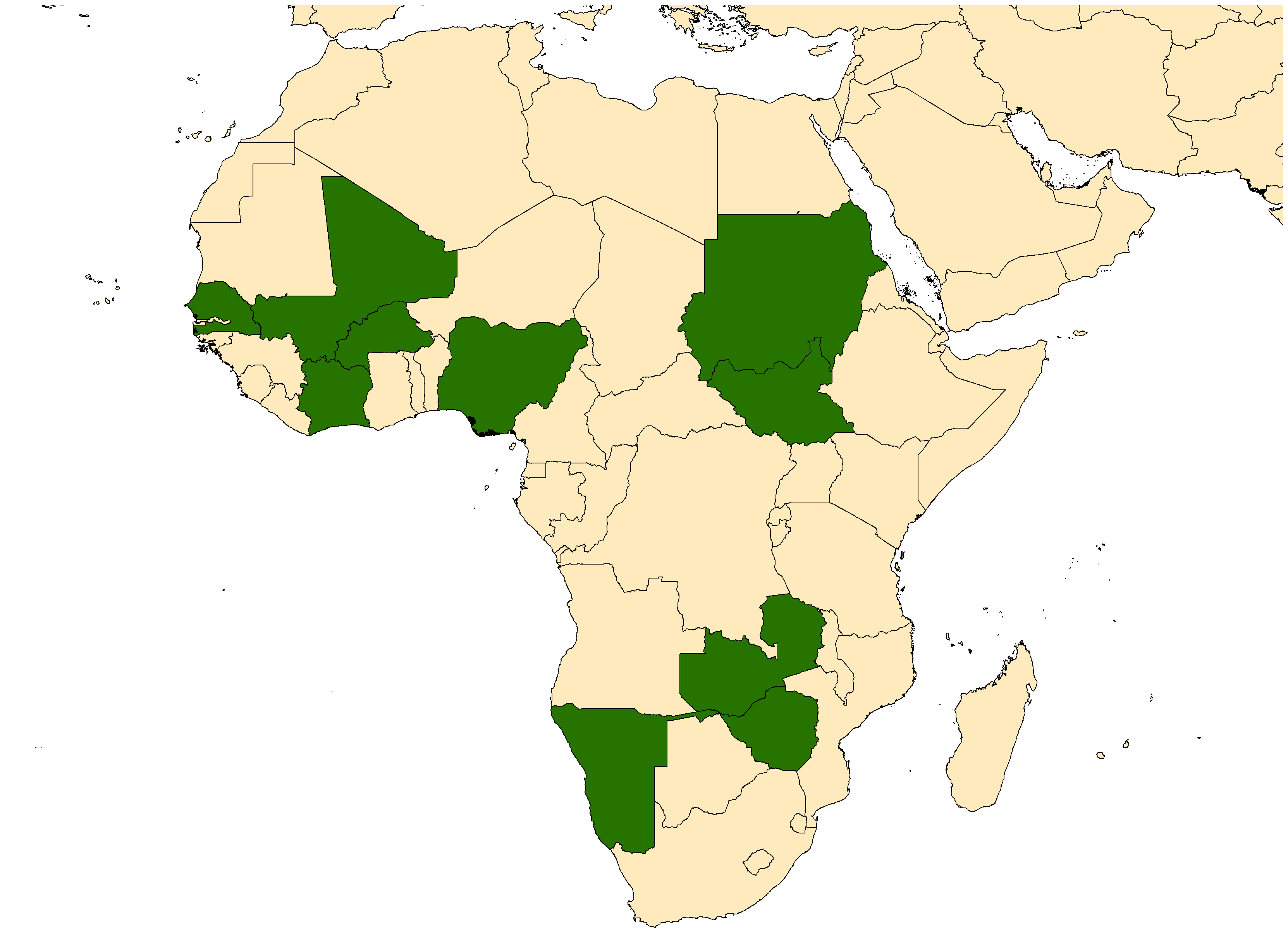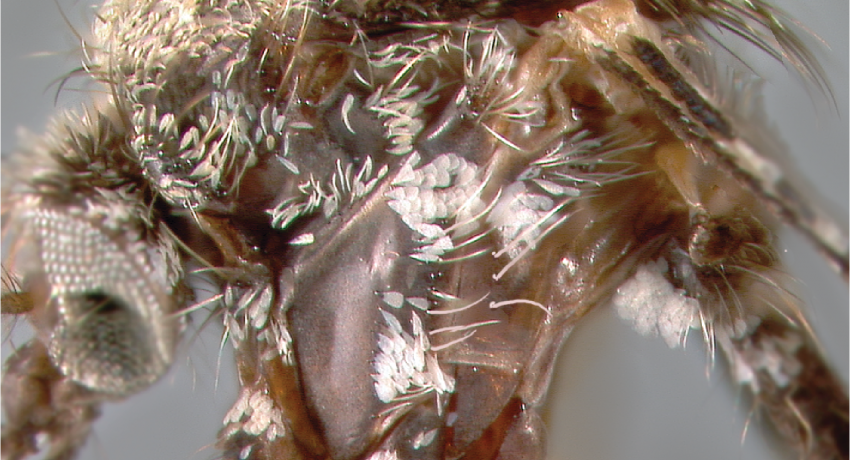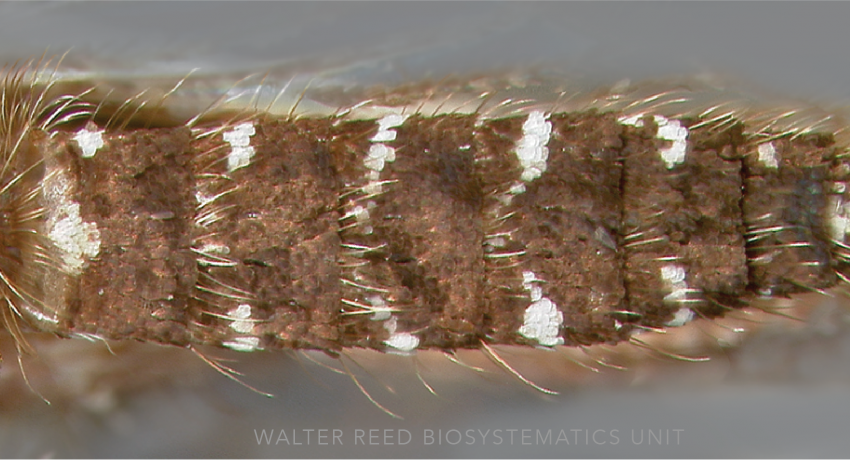AFROTROPICAL REGION
Etymology: A.W. Taylor
Aedes furcifer is the nominal species of the informal Furcifer Group of the Aedes subgenus Diceromyia, which also includes Ae. taylori Edwards and Ae. cordellieri Huang, which are only reliably differentiated on characters of the male genitalia. In adult females, differences in the abundance and patterning of the abdominal scales purportedly separate Ae. furcifer and Ae. taylori. Since the recognition of Ae. cordellieri, populations previously referred to as Ae. taylori in Kenya, Natal province (South Africa), Tanzania and Uganda have been assigned to Ae. cordellieri. The true identity of the “Ae. taylori” populations reportedly responsible for arbovirus transmission in Sudan, and Zimbabwe still needs to be verified.
Type locality: Gadau, Nigeria
Type depository: Natural History Museum, London, United Kingdom (NHMUK)
DIAGNOSTIC CHARACTERS (Click photos to view; mouse over and click large photo to zoom in.)
ADULT (illustrated): Head: Proboscis with broad median pale band. Thorax: Erect forked scales numerous, not restricted to occiput; paratergite with scales; upper prealar area with broad scales; mesepimeral scales present; lower mesepimeral setae present; scutellar lobes all with broad scales; acrostichal and dorsocentral setae well developed; scutum anteriorly uniformly pale, usually golden with dark spots at scutal angles; prescutellar setae well developed. Abdomen: Terga and sterna with no speckling. Legs: Fe-I–III, Ti-I–III, Ta-I–III1 speckled with pale scales. Wing: Alula with broad scales; wing scales broad on all veins, dark mixed with white; tertiary fringe scales mix of pale and dark.
LARVA (not illustrated): No larval characters defined.
TAXONOMIC KEYS
Jupp 1996 (M*, F*; key)
Huang & Rueda 2016 (F*; key)
![]()
WRBU – Aedes – Afrotropical – Larva
Exemplar DNA sequences
Ae. taylori COI: MG242519, AY645232–33
BIONOMICS
Immatures
Immature habitats of Ae. taylori include water collections in tree holes, pineapple tops, steps cut into coconut palms, rock pools, and in artificial containers.
Adults
Aedes taylori are closely associated with Afrotropical forest and forest edge habitats. Aedes taylori feed on monkeys in the canopy, and readily come down to ground level to feed on passing man and baboons, making them important zoonotic disease vectors, particularly in the yellow fever cycle.
DISTRIBUTION NOTES
Burkina Faso, Côte d'Ivoire, Mali, Namibia, Nigeria, Senegal, Sudan & South Sudan, Zambia, Zimbabwe.

WRBU VECTOR HAZARD REPORTS
None; View other WRBU Vector Hazard Reports
Available GIS Models:
None
IMPORTANT REFERENCES (full citations below)
Edwards 1936: 55 (M)
Edwards 1941: 216 (M*, F)
Lewis 1942a: 153 (P, L)
Hopkins 1952: 213 (L*)
Muspratt 1955: 175 (M, L)
van Someren et al. 1955: 481 (tax.)
Port et al. 1981: 163 (distr.; The Gambia)
Ferrara et al. 1985 (1984): 179-183 (F*; furcifer/taylori comparison)
Hervy et al. 1985: 17-24 (L*; furcifer/taylori comparison)
Huang 1986a: 634 (M*; tax.; Furcifer Group)
Jupp 1996 (M*, F*; key)
Huang & Rueda 2016 (F*; key)
CURRENT SYNONYMS
None
CITED REFERENCES
Edwards, F.W. (1936). New African culicine mosquitoes (Diptera, Culicidae). Proceedings of the Royal Entomological Society of London (Series B. Taxonomy), 5(3), 49–55.
Edwards, F.W. (1941). Mosquitoes of the Ethiopian Region. III. Culicine adults and pupae. Bulletin of the British Museum (Natural History) Entomology.
Ferrara, L., Germain, M., & Hervy, J.-P. (1985). Aedes (Diceromyia) furcifer (Edwards, 1913) et Aedes (Diceromyia) taylori Edwards, 1936. Le point sur la differenciation des adultes. Cahier ORSTOM. Série Entomologie Médicale et Parasitologie, 22 (1984) (3), 179–183.
Hervy, J. P., Ferrara, L., & Legros, F. (1985). Aedes (Diceromyia) furcifer (Edwards, 1913) et Aedes (Diceromyia) taylori Edwards, 1936: diagnose des larves de quatrieme stade. Cahier ORSTOM. Série Entomologie Médicale et Parasitologie, 23(1), 17–24.
Hopkins, G.H.E. (1952). Mosquitoes of the Ethiopian region. I. Larval bionomics of mosquitoes and taxonomy of culicine larvae (2nd ed.). London, UK: British Museum (Natural History).
Huang, Y.-M. (1986a). Notes on the Aedes (Diceromyia) furcifer group, with a description of a new species (Diptera: Culicidae). Proceedings of the Entomological Society of Washington, 88, 634–649.
Huang, Y.-M., & Rueda, L.M. (2016). A pictorial key to the sections, groups, and species of the Aedes (Diceromyia) in the Afrotropical Region (Diptera: Culicidae). Zootaxa, 4079(2), 281–290.
Jupp, P.G. (1996). Mosquitoes of southern Africa. Culicinae and Toxorhynchitinae.
Lewis, D.J. (1942a). The early stages of Aedes taylori Edwards and A. furcifer Edwards (Dipt., Culicidae). Proceedings of the Royal Entomological Society of London. Series B, Taxonomy, 11, 153–154.
Muspratt, J. (1955). Research on South African Culicini (Diptera, Culicidae) III. A check-list of the species and their distribution, with notes on taxonomy bionomics and identification. Journal of the Entomological Society of South Africa, 18, 149–207.
Port, G.R., Wilkes, T.J., & Bryan, J.H. (1981). A note on the distribution of Aedes (Diceromyia) furcifer/taylori, a yellow fever vector, in the Gambia. Insect Science and Its Application, 2(3), 163–166.
van Someren, E.C.C., Teesdale, C., & Furlong, M. (1955). The mosquitos of the Kenya Coast; records of occurrence, behaviour and habitat. Bulletin of Entomological Research, 46, 463–493.
CITE THIS PAGE
Walter Reed Biosystematics Unit (Year). Aedes taylori species page. Walter Reed Biosystematics Unit Website, http://wrbu.si.edu/vectorspecies/mosquitoes/taylori, accessed on [date (e.g. 03 February 2020) when you last viewed the site].











































































































































































